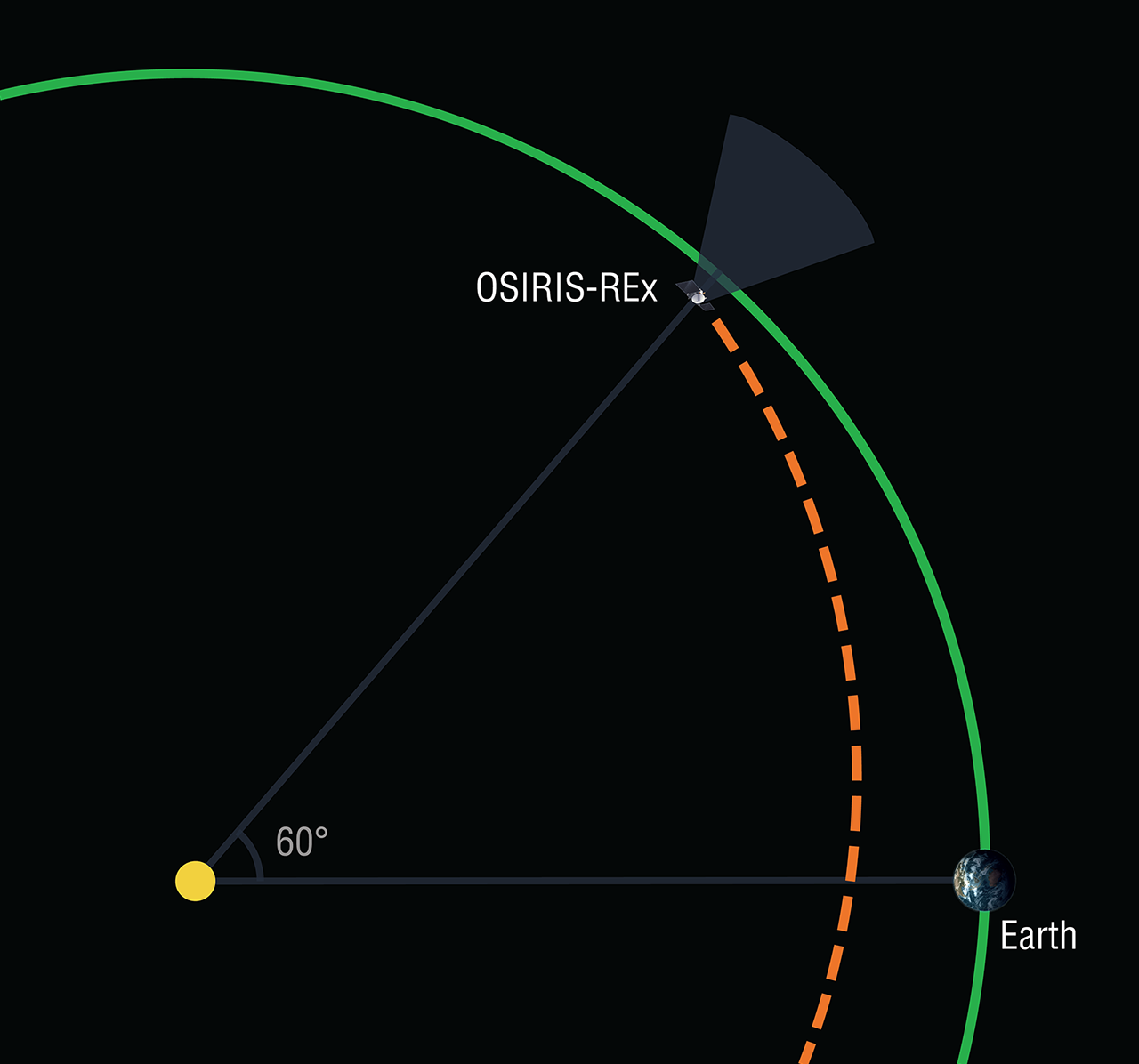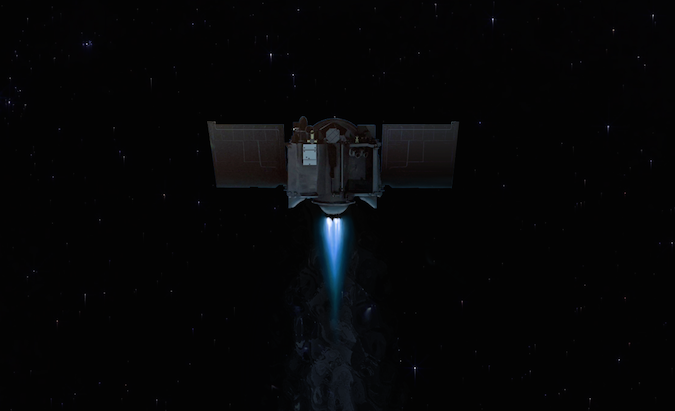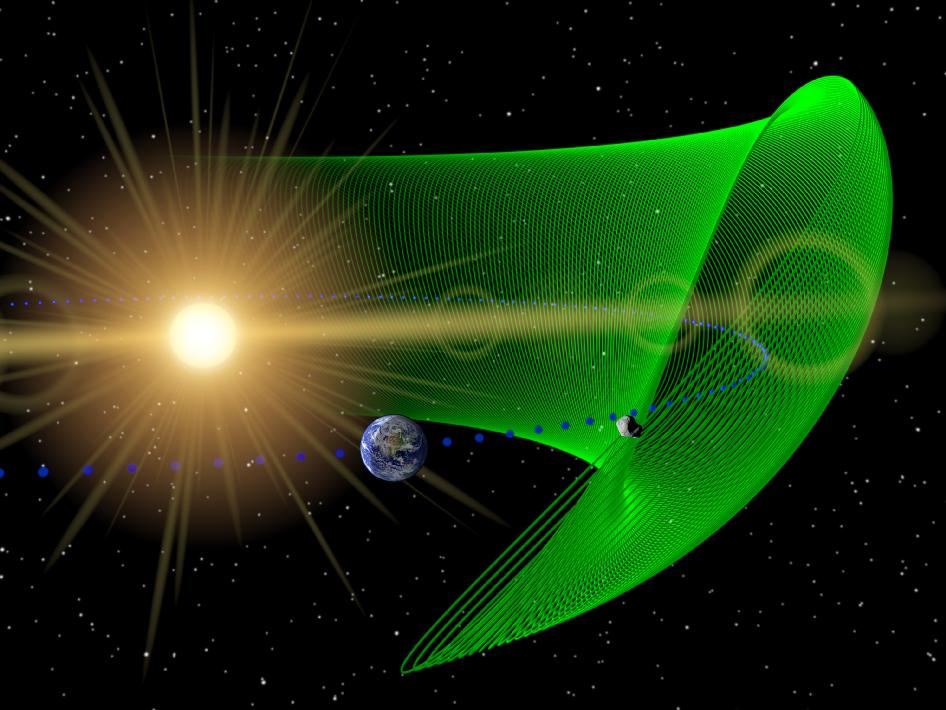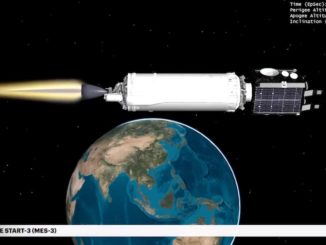
On course to collect specimens from asteroid Bennu after its launch last year, NASA’s OSIRIS-REx spacecraft will search this month for objects sharing an orbit with Earth, a bonus science opportunity to locate possible fragments of the primordial building blocks that formed our home planet.
The long-range observations begin Feb. 9 and run through Feb. 20, using one of the probe’s cameras to look for asteroids embedded in swarms scientists believe lurk ahead of and behind Earth in its orbit around the sun.
Named Earth-Trojans, the objects likely group in clouds at Sun-Earth Lagrange points, where the combined pull of gravity from the bodies would allow asteroids to orbit in lock-step with Earth. The so-called L4 and L5 Lagrange points lead and follow Earth by 60 degrees in its path around the sun.
The same positions in front of and behind Jupiter harbor thousands of Trojan asteroids, and smaller Trojan swarms have been discovered near Venus, Mars, Uranus and Neptune.
It turns out OSIRIS-REx is about to pass through the Sun-Earth L4 Lagrange point, and managers decided to scan the region where Earth-Trojans might be located to see what the spacecraft can find.
Now located nearly 74 million miles (119 million kilometers) from Earth, OSIRIS-REx is on a seven year-journey to asteroid Bennu and back, charged with gathering rock samples from the mountain-sized object and delivering them to scientists for examination inside laboratories on the ground.
Since its launch Sept. 8, 2016, OSIRIS-REx has switched on all of its science instruments and performed a major course correction maneuver to aim for a flyby of Earth this Sept. 22. Earth’s gravity will slingshot the spacecraft toward Bennu.
The Dec. 28 burn changed OSIRIS-REx’s speed by 964 mph (431 meters per second) and consumed a quarter of the probe’s propellant supply. The maneuver was the largest of the mission until the Lockheed Martin-built spacecraft’s arrival burn at Bennu in August 2018.

Another small “clean-up” thruster firing Jan. 18 further tweaked OSIRIS-REx’s trajectory, and the spacecraft switched over to its high-power antenna Jan. 25 to beam data back to Earth at faster rates.
The milestones clear the way for the mission’s first science campaign next week.
“The Earth-Trojan asteroid search provides a substantial advantage to the OSIRIS-REx mission,” said Dante Lauretta, OSIRIS-REx principal investigator from the University of Arizona in Tucson. “Not only do we have the opportunity to discover new members of an asteroid class, but more importantly, we are practicing critical mission operations in advance of our arrival at Bennu, which ultimately reduces mission risk.”
Only one of the elusive Earth-Trojans has been detected to date.
Astronomers using NASA’s WISE infrared telescope confirmed the discovery of an asteroid in 2011 that fit the definition of an Earth-Trojan. Asteroid 2010 TK7 is about 1,000 feet (300 meters) in diameter, and experts predict its extreme orbit, which takes it far above and below the plane of the planets, will be stable for at least the next several thousand years.
Scientists consider 2010 TK7 an outlier of a large group of asteroids sharing Earth’s orbit, some of which may have been there since the solar system formed more than 4.5 billion years ago.
“The orbital motion of 2010 TK7 is chaotic and unstable on billion-year timescales, and it is unlikely to be a remnant from the formation of the Earth,” Lauretta wrote in a blog post describing the upcoming observing campaign. “The existence and size of a primordial population of Earth-Trojans (genuine remnants of the building blocks of our planet) are not well constrained and represents a significant gap in our inventory of small bodies in near-Earth space.”
Earth-Trojans are difficult to find from the ground because they are usually in daylight, and the WISE spacecraft orbiting Earth detected 2010 TK7 because its unique orbit oscillates farther from the sun’s position in the sky than most members of the group.
Current ground-based surveys are only sensitive to Earth-Trojan asteroids bigger than about 3,000 feet, or approximately 1 kilometer, said Carl Hergenrother, an OSIRIS-REx staff scientist at the University of Arizona.

By mid-February, OSIRIS-REx will be “an ideal spot to undertake a survey,” Lauretta wrote.
Between Feb. 9 and Feb. 20, the spacecraft’s mapping camera will take 145 pictures per day of the volume of space where Earth-Trojans are expected to reside, according to Lauretta.
“It’s a big cloud, and there should be material there,” Hergenrother said at a Jan. 12 meeting of NASA’s Small Bodies Assessment Group. “We should be able to detect stuff down to 100 meters (330 feet), and possibly even smaller, depending on the performance of our cameras, and the albedo (reflectivity).
“If we don’t find anything, it either means there’s a lot less objects out there than we were thinking, or they’re a lot smaller,” Hergenrother said.
While Lauretta said there is a scientific motivation for the Earth-Trojan search, the top reason for the campaign is to practice techniques the OSIRIS-REx science team plans to employ once the spacecraft arrives at Bennu.
On approach to Bennu, the probe’s cameras will look near the asteroid to hunt for tiny miniature moons as small as 4 inches (10 centimeters). Navigators want to know the location of any debris around Bennu to prevent a crash with the spacecraft.
Jupiter and several large distant asteroids will be imaged by OSIRIS-REx’s camera when it scans for Earth-Trojans. The images will help the ground team rehearse the complex real-time in-space navigation the mission requires during the rendezvous with Bennu, along with the identification of moving targets mimicking the behavior of potential mini-moons surrounding the asteroid.
Although the scientific objectives are secondary, Lauretta said his team is excited about the prospect of making a discovery so early in the mission.
“We’ll clearly be able to set an upper limit on what’s out there because we know what we could detect if it was there,” Lauretta said at the Jan. 12 science meeting.
OSIRIS-REx could also discover an asteroid from another family that just happens to pass through the camera’s field-of-view, Lauretta said. But scientists will pin down the orbit of any object OSIRIS-REx detects, and an Earth-Trojan asteroid locked in a stable orbit could be evidence of a larger cloud of mini-worlds hidden from view.
“Is this dynamically stable? Could it be a primordial Earth object?” Lauretta asked, posing questions scientists will have if OSIRIS-REx finds anything starting next week. “That would be the most fascinating thing that we could discover.”
Email the author.
Follow Stephen Clark on Twitter: @StephenClark1.



